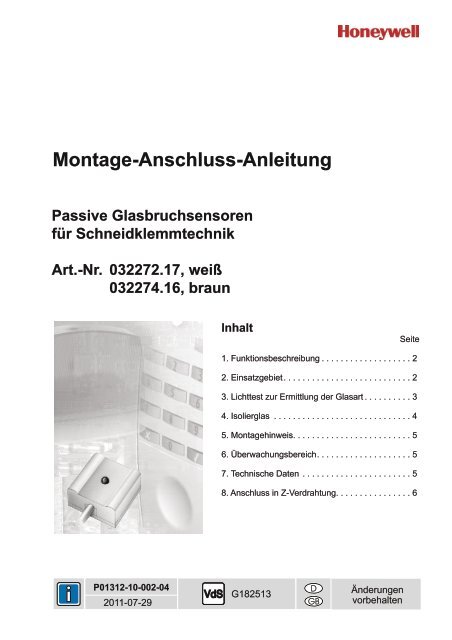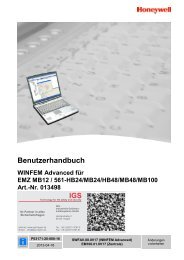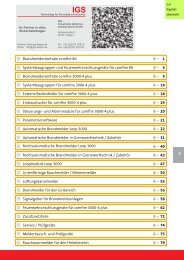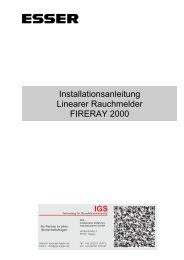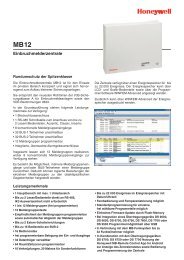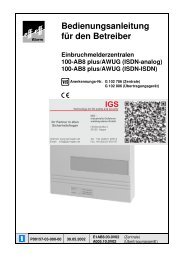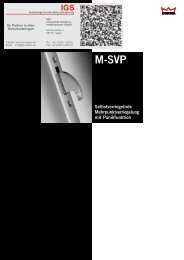Passive Glasbruchsensoren für Schneidklemmtechnik (PDF)
Passive Glasbruchsensoren für Schneidklemmtechnik (PDF)
Passive Glasbruchsensoren für Schneidklemmtechnik (PDF)
Erfolgreiche ePaper selbst erstellen
Machen Sie aus Ihren PDF Publikationen ein blätterbares Flipbook mit unserer einzigartigen Google optimierten e-Paper Software.
Montage-Anschluss-Anleitung<br />
<strong>Passive</strong> <strong>Glasbruchsensoren</strong><br />
für <strong>Schneidklemmtechnik</strong><br />
Art.-Nr. 032272.17, weiß<br />
032274.16, braun<br />
Inhalt<br />
Seite<br />
1. Funktionsbeschreibung . . . . . . . . . . . . . . . . . . . 2<br />
2. Einsatzgebiet. . . . . . . . . . . . . . . . . . . . . . . . . . . 2<br />
3. Lichttest zur Ermittlung der Glasart . . . . . . . . . . 3<br />
4. Isolierglas . . . . . . . . . . . . . . . . . . . . . . . . . . . . . 4<br />
5. Montagehinweis. . . . . . . . . . . . . . . . . . . . . . . . . 5<br />
6. Überwachungsbereich. . . . . . . . . . . . . . . . . . . . 5<br />
7. Technische Daten . . . . . . . . . . . . . . . . . . . . . . . 5<br />
8. Anschluss in Z-Verdrahtung. . . . . . . . . . . . . . . . 6<br />
P01312-10-002-04<br />
2011-07-29<br />
G182513<br />
D<br />
GB<br />
Änderungen<br />
vorbehalten
2 Montage-Anschluss-Anleitung <strong>Passive</strong> <strong>Glasbruchsensoren</strong><br />
1. Funktionsbeschreibung<br />
<strong>Passive</strong> <strong>Glasbruchsensoren</strong> dienen der Überwachung von Glasscheiben auf Bruch.<br />
Ein Glasbruchsensor wird auf eine Scheibe geklebt. Er ist mit einem Piezokristall ausgestattet und<br />
registriert damit alle auf der Scheibe eintreffenden Schallereignisse.<br />
Zersplitterndes Glas (z. B. bei einem Einbruch) verursacht ein ganz bestimmtes Geräusch in der<br />
Glasscheibe (=spezifisches Frequenzspektrum). Dieses Geräusch wird von dem Glasbruchsensor<br />
für berstendes Glas als typisch erkannt. Nur wenn dieses typische Frequenzspektrum vorliegt, löst<br />
der Melder Alarm aus.<br />
2. Einsatzgebiet:<br />
<strong>Passive</strong> <strong>Glasbruchsensoren</strong> sind auf allen Silikatgläsern, die auf beiden Seiten der Innenscheibe<br />
glatt sind, einsetzbar.<br />
Nicht einsetzbar sind passive <strong>Glasbruchsensoren</strong> auf:<br />
- Kunststoffscheiben Q<br />
- Verbundglas,<br />
Aussenscheibe<br />
- Butzenglasscheiben<br />
(Glasart beliebig)<br />
- Strukturglas<br />
- Glas mit Drahteinlage<br />
Rahmen<br />
Luftspalt<br />
Innenscheibe<br />
(auf beiden Seiten glatt)<br />
Glasbruchsensor<br />
Q Scheiben aus Kunststoff (Polykarbonat) bestehen aus mehreren Schichten. Die Art der Fortpflanzung<br />
von Schallwellen ist für den Einsatz eines Glasbruchsensors nicht geeignet. Ausserdem besteht<br />
beim Aufkleben eines Glasbruchsensors die Gefahr, dass die oberste Schicht der Scheibe<br />
angegriffen wird.<br />
Wenn Sie nicht sicher sind, ob es sich um eine Glas- oder Kunststoffscheibe handelt, wenden Sie<br />
sich bitte an den Hersteller der Scheibe.<br />
Scheiben, bei denen der passive Glasbruchsensor nicht eingesetzt werden kann:<br />
Klebefolie<br />
2 Glasscheiben<br />
mit Folie<br />
verklebt<br />
Verbundglas<br />
Butzenglas<br />
Strukturglas<br />
Glas mit Drahteinlage
Montage-Anschluss-Anleitung <strong>Passive</strong> <strong>Glasbruchsensoren</strong><br />
3<br />
Weshalb kann ein passiver Glasbruchsensor nicht auf Scheiben mit irgendeiner Struktur<br />
eingesetzt werden?<br />
Die folgende Abbildung zeigt an einem einfachen Beispiel, dass die Ausbreitung der Wellen von<br />
einem Hindernis gestoppt werden kann.<br />
Schwimmring<br />
Stein<br />
Wasseroberfläche<br />
Wellen<br />
Hier wird die Ausbreitung der Wellen gestoppt<br />
Die Wellenbewegung kann hier<br />
nicht erkannt werden<br />
3. Lichttest zur Ermittlung der Glasart<br />
Ob es sich um Normalglas, Isolierglas oder Verbundglas handelt, lässt sich einfach mit einer Lichtquelle<br />
feststellen. Für den Lichttest empfehlen wir als Lichtquelle einen Laserpointer oder ein Laser-Messgerät<br />
für Scheiben (z.B. Merlin Laser der Fa. Bohle, D 42755 Haan, Tel. 0 21 29 / 55 68-0).<br />
Dazu hält man die Lichtquelle senkrecht auf die Scheibe und blickt im flachen Winkel darauf.<br />
Die physikalischen Vorgänge sind dabei folgende:<br />
Tritt Licht durch eine Glasscheibe, wird an den Übergängen Luft - Glas und Glas - Luft ein Teil davon<br />
reflektiert. Dadurch werden 2 Spiegelbilder erzeugt, die deutlich zu sehen sind, wenn man in<br />
einem flachen Winkel auf die Scheibe blickt. Der Abstand entspricht in etwa der Dicke der Scheibe.<br />
Hinweis:<br />
Der Lichttest funktioniert nicht bei allen Glasarten (z.B. Scheiben aus Kunststoff, die einzelnen<br />
Scheiben können nicht erkannt werden).<br />
Im Zweifelsfall muss der genaue Glastyp beim Hersteller der Scheibe erfragt werden!<br />
Scheibe<br />
Scheibe<br />
Scheibe 2<br />
Scheibe<br />
Scheibe 1<br />
Blickrichtung<br />
Blickrichtung<br />
Blickrichtung<br />
Lichtquelle<br />
Normalglas:<br />
1 doppelter Lichtpunkt<br />
ist zu sehen<br />
Lichtquelle<br />
2 Scheiben (z.B. Isolierglas):<br />
2 doppelte Lichtpunkte<br />
sind zu sehen<br />
Lichtquelle<br />
Verbundglas:<br />
3 Lichtpunkte<br />
sind zu sehen
4 Montage-Anschluss-Anleitung <strong>Passive</strong> <strong>Glasbruchsensoren</strong><br />
4. Isolierglas - die am häufigsten eingesetzte Glasart<br />
Isolierglas besteht aus mindestens 2 Scheiben, die durch einen Luftspalt getrennt sind. Üblich sind 2<br />
verschiedene Ausführungen:<br />
1. Beide Scheiben bestehen aus Normalglas<br />
Bei diesen Scheiben ist eine Überwachung durch passive <strong>Glasbruchsensoren</strong> problemlos möglich.<br />
(Hinweis: 2 Scheiben sind üblich, mehr als 2 Scheiben sind selten)<br />
2. Verbund-Isolierglas<br />
Bei Verbund-Isolierglas besteht eine Scheibe aus Verbundglas, die andere aus Normalglas.<br />
ACHTUNG:<br />
Beim Einbau der Scheibe muss darauf geachtet werden, dass die Verbundglasscheibe<br />
nach außen eingesetzt wird. Jetzt kann die Innenscheibe (Normalglas) mit<br />
einem passiven Glasbruchsensor überwacht werden.<br />
Außenscheibe<br />
Normalglas<br />
Luftspalt /Gasgemisch<br />
Außenscheibe<br />
3-Scheiben Verbundglas<br />
verklebt<br />
Luftspalt /<br />
Gasgemisch<br />
1. Schicht<br />
2. Schicht<br />
3. Schicht<br />
Innenscheibe<br />
Normalglas<br />
Innenscheibe<br />
Normalglas<br />
Glasbruchsensor<br />
Glasbruchsensor<br />
Rahmen<br />
Rahmen<br />
Aufbau eines 2-Scheiben-Isolierglases<br />
Aufbau eines Verbund-Isolierglases
Montage-Anschluss-Anleitung <strong>Passive</strong> <strong>Glasbruchsensoren</strong><br />
5<br />
5. Montagehinweise für passive <strong>Glasbruchsensoren</strong><br />
Ein passiver Glasbruchsensor ist gemäß folgender Abbildung auf die Innenscheibe zu kleben. Der<br />
Mindestabstand von 2 cm zum Rahmen ist einzuhalten. Für die Positionierung während des Klebevorgangs<br />
steht eine Klebevorrichtung zur Verfügung. Bei der Kabelführung ist an Kippfenstern eine<br />
entsprechende Schlaufe zu berücksichtigen, damit das Fenster beim Kippen das Kabel nicht beschädigt<br />
(siehe Abbildung).<br />
Beachten Sie bitte, dass nur eine<br />
Kombination zwischen einem Glasbruchsensor<br />
(Durchbruchüberwachung)<br />
und einem Magnetkontakt<br />
(Öffnungsüberwachung) sinnvoll ist.<br />
6. Überwachungsbereich<br />
Kabelschlaufe berücksichtigen,<br />
damit das Fenster gekippt<br />
werden kann.<br />
2cm<br />
r = 2m<br />
2cm<br />
2cm<br />
7. Technische Daten<br />
Ruhestromaufnahme £ 1µA<br />
Detektionsradius<br />
200 cm, unabhängig<br />
von der Glasdicke<br />
Betriebstemperaturbereich -10 °C bis +70 °C<br />
Lagerungstemperaturbereich -25 °C bis +70 °C<br />
Umweltklasse gemäß VdS<br />
II<br />
Schutzart nach DIN 40050<br />
IP67<br />
Abmessungen (L x B x H)<br />
22 x 22 x 12,2 mm<br />
Farbe verkehrsweiß (ähnlich RAL 9016)<br />
braun (ähnlich RAL 8017)<br />
Kabel auch geeignet für <strong>Schneidklemmtechnik</strong><br />
Steuerleitung LIYY<br />
4x0,14 mm²<br />
Leiter E-Cu, verzinnt 7x0,16 mm<br />
Aderndurchmesser<br />
0,95 mm ±0,05 mm<br />
Außendurchmesser<br />
3,20 mm -0,20 mm
6 Montage-Anschluss-Anleitung <strong>Passive</strong> <strong>Glasbruchsensoren</strong><br />
8. Anschluss in Z-Verdrahtung<br />
8.1 Prinzip<br />
Die Z-Verdrahtung dient der erhöhten Betriebs- und Sabotagesicherheit. Dazu werden die Melder<br />
4-adrig angeschlossen. Folgende Abbildung zeigt das Prinzip:<br />
Abschlusswiderstand<br />
Zentrale<br />
Eingang<br />
Ausgang<br />
Hinweis:<br />
Mehrere Melder werden in Reihe geschaltet.<br />
Der gemeinsame Abschlusswiderstand befindet sich am letzten Melder.<br />
8.2 Beispiel: 3 <strong>Glasbruchsensoren</strong> in Reihe geschaltet<br />
Verteiler<br />
Abschlusswiderstand<br />
Zentrale<br />
E<br />
E<br />
A<br />
A<br />
Der Anschluss des Kabels erfolgt durch jeweils 2 nebeneinanderliegende Leitungen für Ein- und<br />
Ausgang. Es ist dabei unerheblich, welche 2 Leitungen verwendet werden: Die Reihenschaltung gemäß<br />
obiger Abbildung ist immer sichergestellt.<br />
Darstellung: Kabelquerschnitt<br />
Zentrale E A E A E A<br />
Abschlusswiderstand<br />
E=Eingang<br />
A=Ausgang
Montage-Anschluss-Anleitung <strong>Passive</strong> <strong>Glasbruchsensoren</strong><br />
7<br />
8.3 Beispiel: 2 Fenster mit <strong>Glasbruchsensoren</strong> und Magnetkontakten in<br />
einer Meldergruppe<br />
Wichtiger Hinweis: Beachten Sie bei der Verdrahtung unbedingt das Kapitel "Erdung / Schirmung”<br />
in der Installationsanleitung der betreffenden Zentrale.<br />
zur Zentrale<br />
V<br />
Verteiler 1<br />
MK 1 MK 2<br />
Verteiler 2<br />
V<br />
Magnetkontakt (MK)<br />
Magnetkontakt (MK)<br />
GB 1 GB 2<br />
<strong>Glasbruchsensoren</strong> (GB)<br />
Anschlussschema:<br />
GB 1 GB 2 MK 2 MK 1<br />
Abschlusswiderstand<br />
Zentrale<br />
Verteiler 1<br />
Verteiler 2 Verteiler 1<br />
Zentrale<br />
GB<br />
E A<br />
E A<br />
GB<br />
E A<br />
E A<br />
MK<br />
E A<br />
A E<br />
MK<br />
E A<br />
A E<br />
Abschlusswiderstand<br />
Kabelquerschnitte<br />
Hinweis:<br />
Immer zuerst die <strong>Glasbruchsensoren</strong>, dann die Magnetkontakte anschliessen!<br />
Beim Magnetkontakt muss der Anschluss diagonal erfolgen!
Honeywell Security Group<br />
Novar GmbH<br />
Johannes-Mauthe-Straße 14<br />
D-72458 Albstadt<br />
www.honeywell.com/security/de<br />
P01312-10-002-04<br />
2011-07-29<br />
© 2011 Novar GmbH
Mounting and Connection Instructions<br />
<strong>Passive</strong> Glass Breakage Sensors<br />
for IDC method of termination<br />
Item no. 032272.17, white<br />
032274.16, brown<br />
Contents<br />
1. Functional description . . . . . . . . . . . . . . . . . . . 10<br />
2. Application . . . . . . . . . . . . . . . . . . . . . . . . . . . . 10<br />
3. Lighttest for determining the type of glass . . . . 11<br />
4. Insulation glass . . . . . . . . . . . . . . . . . . . . . . . . 12<br />
5. Mounting instructions. . . . . . . . . . . . . . . . . . . . 13<br />
6. Monitoring range . . . . . . . . . . . . . . . . . . . . . . . 13<br />
7. Technical data . . . . . . . . . . . . . . . . . . . . . . . . . 13<br />
8. Z-wiring connection . . . . . . . . . . . . . . . . . . . . . 14<br />
P01312-10-002-04<br />
2011-07-29<br />
G182513<br />
D<br />
GB<br />
Subject to change<br />
without notice
10 Mounting and Connection Instructions <strong>Passive</strong> Glass Breakage Sensors<br />
1. Functional description<br />
<strong>Passive</strong> glass breakage sensors are used for monitoring glass panes for breakage.<br />
A glass breakage sensor is stuck to a pane. It is fitted with a Piezo cristal, thus registering all sonic<br />
occurances affecting the pane.<br />
Breaking glass (e.g. during a break-in) generates a particular noise (=specific frequency spectrum).<br />
This noise is detected as the typical sound of shattering glass by the glass breakage sensor. The<br />
signal alarm is only triggered if this typical frequency spectrum occurs.<br />
2. Application:<br />
<strong>Passive</strong> glass breakage sensors can be used with all silicate glasses with smooth surfaces on both<br />
sides of the inner pane.<br />
<strong>Passive</strong> glass breakage sensors cannot be used on:<br />
- Plastic panes Q<br />
- Laminated glass,<br />
- Bull’s eyes<br />
- Structured glass<br />
- Glass with wire insert<br />
Outer pane<br />
(any glass type)<br />
Frame<br />
Air gap<br />
Inner pane<br />
(smooth on both sides)<br />
Glass breakage sensor<br />
Q Plastic panes (polycarbonate) consist of several layers. The manner in which sound waves are propagated<br />
is not suitable for the use of a glass breakage sensor. Additionally, adhering a glass breakage<br />
sensor could lead to the uppermost layer of the pane being attacked.<br />
Please contact the manufacturer of the pane in question if you are not sure whether a plastic or<br />
glass pane is involved.<br />
<strong>Passive</strong> glass breakage sensors cannot be used with the following panes:<br />
Adhesive foil<br />
2 glass panes<br />
with adhesive foil<br />
Laminated glass<br />
Bull’s eyes<br />
Structured glass<br />
Glass with wire insert
Mounting and Connection Instructions <strong>Passive</strong> Glass Breakage Sensors<br />
11<br />
Why can a passive glass breakage sensor not be used on panes with any type of<br />
structure?<br />
The following illustration demostrates in a simple example that the expansion of waves can be<br />
stopped by an obstacle.<br />
Swimming ring<br />
Stone<br />
Water surface<br />
Waves<br />
The waves are stopped here<br />
Wave movement cannot be<br />
detected here<br />
3. Light test for determining the type of glass<br />
A light test can be used to simply ascertain whether one is dealing with normal glass, insulation<br />
glass or laminated glass (Laserpointer or similar).<br />
Hold the light source vertically against the pane and observe at a flat angle.<br />
The following physical processes are observed:<br />
Light penetrating a glass pane is reflected in part at the air - glass and glass - air transitions. This<br />
creates 2 reflections which can be clearly seen if one gazes at the pane at a flat angle. The distance<br />
is approximately equivalent to the thickness of the pane.<br />
Note:<br />
The light test does not function for all types of glass (e.g. plastic panes, where the individual panes<br />
cannot be identified).<br />
Ask the pane manufacture what glass type exactly is involved in case of doubt!<br />
Pane<br />
Pane 2<br />
Pane<br />
Pane<br />
Pane 1<br />
View<br />
View<br />
View<br />
Light source<br />
Normal glass:<br />
A double light spot<br />
can be seen<br />
Light source<br />
2 panes (e.g. insulation glass):<br />
2 double light spots<br />
can be seen<br />
Light source<br />
Laminated glass:<br />
3 light spots<br />
can be seen
12 Mounting and Connection Instructions <strong>Passive</strong> Glass Breakage Sensors<br />
4. Insulation glass - the most widely-used type of glass<br />
Insulation glass consists of at least 2 panes separated by an air gap. There are generally 2 different<br />
versions:<br />
1. Both panes are manufactured from normal glass<br />
Monitoring with passive glass breakage sensors can be realised without any problems when dealing<br />
with these panes.<br />
(Note: 2 panes are usual, more than 2 panes are rare)<br />
2. Laminated insulation glass<br />
Laminated insulation glass consists of one pane of laminated glass and another made of normal glass.<br />
WARNING:<br />
Ensure that the laminated glass pane is facing outwards when installing the pane.<br />
The inner pane (normal glass) can now be monitored with a passive glass breakage<br />
sensor.<br />
Outer pane<br />
Normal glass<br />
Air gap /Gas mixture<br />
Outer pane<br />
3-pane laminated<br />
glass with adhesive foil<br />
Air gap /Gas mixture<br />
1st layer<br />
2ndlayer<br />
3rd layer<br />
Inner pane<br />
Normal glass<br />
Inner pane<br />
Normal glass<br />
Glass breakage sensor<br />
Glass breakage sensor<br />
Frame<br />
Frame<br />
Structure of 2-pane insulation glass<br />
Structure of laminated insulation glass
Mounting and Connection Instructions <strong>Passive</strong> Glass Breakage Sensors<br />
13<br />
5. Mounting instructions for passive glass breakage sensors<br />
A passive glass breakage sensor should be stuck to the inner pane as shown in the following illustration.<br />
The minimum distance of 2 cm from the frame should be adhered to. A gluing gauge is provided for<br />
positioning during adhering. A suitable loop should be provided in the case of bottom-hinged (hopper)<br />
windows when laying cable so that the cable is not damaged when the window is tilted (see illustration).<br />
Please note that the only practical<br />
solution is a combination of glass<br />
breakage sensor (break-through<br />
warning) and a magnetic contact<br />
(opening monitor).<br />
6. Monitoring range<br />
Provide a loop to allow the<br />
window to be tipped.<br />
2cm<br />
r = 2m<br />
2cm<br />
7. Technical data<br />
Current consumption £ 1µA<br />
Detection radius<br />
200 cm, independent<br />
of the glass-thickness<br />
Operating temperature range -10 °C to +70 °C<br />
Storage temperature range -25 °C to +70 °C<br />
Environmental class as per VdS<br />
II<br />
Protection class as per DIN 40 050<br />
IP67<br />
Dimensions (W x H x D)<br />
22 x 22 x 12,2 mm<br />
Color traffic white (similar to RAL 9016)<br />
brown (similar to RAL 8017)<br />
Conductor also suited for IDC method of termination<br />
Control cable LIYY<br />
4x0.14 mm²<br />
Conductor E-Cu, tin-plated 7x0.16 mm<br />
Wire diameter<br />
0.95 mm ±0.05 mm<br />
Outside diameter<br />
3.20 mm -0.20 mm<br />
2cm
14 Mounting and Connection Instructions <strong>Passive</strong> Glass Breakage Sensors<br />
8. Z-wiring connection<br />
8.1 Principle<br />
Z-wiring increases operationing reliability and sabotage security. Detectors are connected in a 4-wire<br />
configuration for this purpose. The following illustration demonstrates the principle:<br />
End of line<br />
resistor<br />
Control unit<br />
Input<br />
Output<br />
Note:<br />
Several detectors are connected in series.<br />
The common end of line resistor is located on the last detector.<br />
8.2 Example: 3 glass breakage sensors connected in series<br />
Distributor<br />
End of line<br />
resistor<br />
Control unit<br />
I<br />
I<br />
O<br />
O<br />
The cable is connected in each case with 2 parallel lines for input and output. It is irrelevant which 2<br />
wires are used: the serial connection shown in the illustration above is always ensured.<br />
Diagram: cable cross section<br />
Control unit I O I O I O<br />
End of line resistor<br />
I =Input<br />
O=Output
Mounting and Connection Instructions <strong>Passive</strong> Glass Breakage Sensors<br />
15<br />
8.3 Example: 2 window with glass breakage sensor and magnetic contacts<br />
in a detector group<br />
Important: Please note the chapter "Earthing / Shielding" in the installation instructions for the<br />
respective control panel when wiring.<br />
Control unit<br />
D<br />
Distributor 1<br />
MC 1 MC 2<br />
Distributor 2<br />
D<br />
Magnetic<br />
contact<br />
(MC)<br />
Magnetic<br />
contact<br />
(MC)<br />
GB 1 GB 2<br />
Glass breakage sensors (GB)<br />
GB 1 GB 2 MC 2 MC 1<br />
End of line<br />
resistor<br />
Control unit<br />
Control unit<br />
Distributor 1<br />
GB<br />
E A<br />
E A<br />
E<br />
E<br />
GB<br />
Distributor 2 Distributor 1<br />
A<br />
A<br />
E<br />
A<br />
MC<br />
A<br />
E<br />
E<br />
A<br />
MC<br />
A<br />
E<br />
End of line<br />
resistor<br />
Cable cross sections<br />
Note:<br />
Always connect the glass breakage sensors first, followed by the magnetic<br />
contacts!
Honeywell Security Group<br />
Novar GmbH<br />
Johannes-Mauthe-Straße 14<br />
D-72458 Albstadt<br />
www.honeywell.com/security/de<br />
P01312-10-002-04<br />
2011-07-29<br />
© 2011 Novar GmbH


